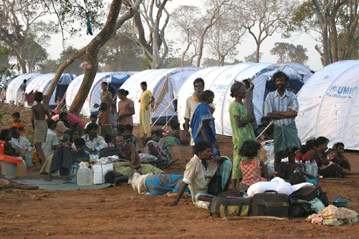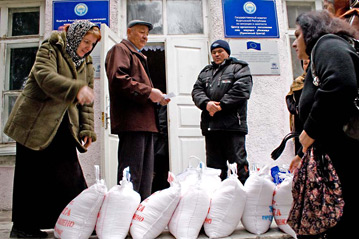UNHCR completes refugee transfer from major border towns in Chad
UNHCR completes refugee transfer from major border towns in Chad

ABECHE, Chad, July 30 (UNHCR) - As UNHCR completes the relocation of Sudanese refugees from several major border sites in eastern Chad, the agency and its partners are testing out a groundbreaking way to find scarce water for the refugees in its desert camps.
This week, the UN refugee agency completed the transfer of refugees from Bahai and Cariari, near the Chad-Sudan border, to Oure Cassoni camp in north-eastern Chad. The 14,673 refugees were moved in less than three weeks despite obstacles like heavy rains and flooded riverbeds.
Likewise, refugees further south in Tine border town have been relocated to Mile camp further inland as UNHCR completes the operation. This leaves just 7,500 around the border town of Adré who remain to be relocated to a new camp at Treguine when the site is ready.
UNHCR is also monitoring the area around Bamina, located between Bahai and Tine, for refugees who may want to move to a camp.
In all, there are now more than 142,000 Sudanese refugees in UNHCR's nine camps in eastern Chad, most of whom have arrived on the agency's convoys from the border.
In Breidjing camp, the Chadian government refugee agency, CNAR, has completed the registration of 6,296 refugees who arrived in the camp on their own after walking from Adré. These refugees have received one-month food rations from the World Food Programme and relief items like plastic sheeting and kitchen sets from UNHCR. To decongest the camp which already hosts some 30,000 people, the refugee agency plans to transfer this group to Treguine camp when it opens.
Meanwhile, at the makeshift site of Am Nabak, UNHCR has sent a registration officer to start a new registration to confirm the varying estimates of the number of refugees who have gathered there. After an initial reluctance, some of them have expressed a willingness to be moved to another location from Am Nabak, where there is not enough water to set up a camp. UNHCR is looking for an alternative site for them.
"Lack of adequate water is the greatest constraint to our operations to help refugees in Chad but a just-completed survey using new technology to find hidden water sources in eastern Chad has shown positive initial results which may help alleviate the dire water shortages," announced UNHCR spokeswoman Jennifer Pagonis at a news briefing in Geneva on Friday.
The refugee agency worked with UNOSAT and French company Radar Technologies France, using radar and optical satellite images as well as three-dimensional images taken by the US Space Shuttle to evaluate a 2,250-km2 region around the northern town of Iriba.
"The images identify land formations such as faults, dykes and seasonal river beds, geological features such as granite, sand and basalt rock surfaces, and elevations and sloping to determine water flow," explained Pagonis. "The combination of this data has allowed us to identify areas with higher potential for ground water."
This is the first time such technology has been applied in a humanitarian emergency, and the initial results have been positive. In a just-completed three-week mission to evaluate the accuracy of the imaging technology, significant quantities of water were discovered each time wells or boreholes were dug in areas suggested by the survey.
"The images have helped target sites for new wells and boreholes in three existing camps - Oure Cassoni, Touloum and Iridimi - and work is underway to dig for water at these points," said Pagonis. "The survey has also helped identify potential sites for new camps and rule out others due to lack of water potential. This study also paves the way towards sustainable water management in the region."









